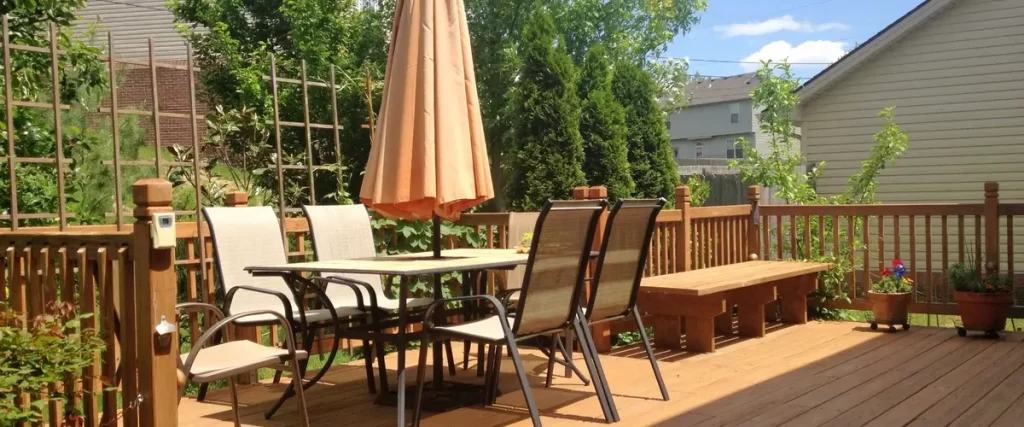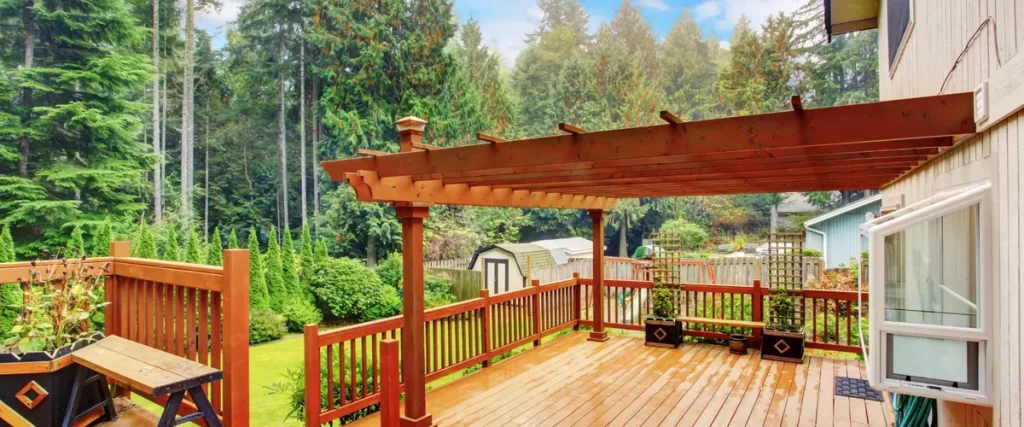Your deck is one of the best places to relax, but it’s also one of the most vulnerable parts of your home. Constant exposure to sun, rain, snow, and wind can take a toll. The good news? A little maintenance can go a long way.
Let’s talk about how you can protect your deck from weather damage and keep it looking great for years.

Start with a Strong Foundation
A sturdy deck begins with quality materials. If you’re building a new deck, choosing the right materials is crucial. Pressure-treated wood, composite decking, or naturally weather-resistant options like cedar or redwood are your best bets. These materials can handle tough conditions and last longer without major issues.
For existing decks, inspect the structure. Look for weak spots, wobbly railings, or any signs of wear and tear. Addressing these problems early prevents bigger headaches later.
Keep It Clean
Dirt, debris, and moisture are a deck’s worst enemies. Regular cleaning not only keeps your deck looking fresh but also prevents damage. Grab a broom or leaf blower to remove leaves and debris. Use a garden hose to wash away dirt. For tougher grime, a mild soap solution and a stiff-bristle brush work wonders.
Cleaning your deck often stops moisture from building up, which can lead to rot or mold. Plus, it keeps the surface safe for walking and prevents slipping hazards.
Seal the Deal with a Protective Coating
One of the best ways to shield your deck from the elements is by applying a protective sealant. Sealants repel water, block UV rays, and prevent cracking or warping. For wood decks, use a stain-and-sealer combo. It enhances the natural beauty of the wood while adding a layer of protection.
Make sure to reseal your deck every two to three years, or as recommended by the product label. If water stops beading on the surface, it’s time for a fresh coat.
Watch Out for Water Damage
Water is a big threat to any deck. After a heavy rain or snowfall, check for puddles or pooling water. These spots can weaken your deck over time. Use a squeegee or broom to remove standing water quickly. You can also sand down areas where water tends to collect, creating a slight slope for better drainage.
If you notice any boards starting to warp, act fast. Replace damaged wood to keep your deck strong and safe.
Protect Against Sun Damage
The sun can fade and dry out your deck, especially during summer. Applying a UV-blocking stain or sealant helps minimize sun damage. If your deck gets a lot of direct sunlight, consider adding some shade. Umbrellas, pergolas, or even strategically planted trees can help keep your deck cool and reduce fading.
Stay Ahead with Regular Inspections
One of the easiest ways to protect your deck is by keeping an eye on it. Regularly inspect every part of your deck for signs of wear or damage. Look closely at the deck boards, railings, and stairs. Are there any cracks, splits, or loose nails? These are small issues now but can turn into big problems if ignored.
Check underneath your deck too. The underside can often hide moisture buildup or signs of rot. Don’t forget the joists and support beams—these are critical for your deck’s strength. A quick look once every few months can save you a lot of trouble down the line.
Say No to Mold and Mildew
Mold and mildew can creep up on your deck, especially in shady areas or after rainy weather. These not only look bad but can also weaken the wood over time. If you notice dark spots or slippery areas, it’s time to act.
A mix of mild soap and water usually does the trick. Scrub the spots with a stiff-bristle brush, rinse thoroughly with a garden hose, and let the deck dry completely. If the mold is stubborn, you can use a gentle cleaner made for decks. The key is tackling the issue early before it spreads.
Protect Your Deck During Winter
Winter is tough on decks, especially when snow and ice are involved. The weight of snow can cause stress on the deck structure while melting snow can lead to moisture damage.
To keep your deck safe, regularly clear off snow using a plastic shovel. Avoid metal shovels – they can scratch or gouge the surface. For ice, skip the rock salt and opt for a deck-friendly ice melt product. These are less harsh on the material and still get the job done.
If you live in an area with heavy snowfall, consider covering your deck with a tarp. This prevents snow from piling up and protects your deck from constant moisture exposure.
Avoid Common Maintenance Mistakes
Sometimes, even with good intentions, mistakes can harm your deck. For example, pressure washing can be helpful, but if you use too much force, it can damage the wood or strip away protective coatings. Always use a gentle setting and hold the nozzle a few feet away from the surface.
Another mistake? Ignoring small problems. A single loose board or wobbly railing may not seem like a big deal, but it can lead to accidents or bigger repairs. Tackle these issues as soon as you notice them.
Lastly, avoid dragging heavy furniture across the deck. This can scratch or dent the surface. Use furniture pads or lift items instead.
Add a Touch of Shade
Too much sun can dry out your deck and make it fade faster. If your deck gets a lot of sunlight, adding shade can make a big difference. Options like umbrellas, awnings, or pergolas not only protect your deck but also make the space more comfortable.
You can also plant trees or tall shrubs nearby for natural shade. Bonus: this adds a bit of greenery and privacy to your outdoor space.
Don’t Overlook Hardware
While it’s easy to focus on the wood, the hardware holding your deck together is just as important. Bolts, screws, and nails can rust over time, especially if they’re exposed to moisture. This weakens the structure and poses safety risks.
Check all the hardware during your inspections. Replace rusty or loose screws and nails with weather-resistant alternatives like stainless steel or galvanized hardware. These last longer and keep your deck safer.
Give It a Fresh Look
Every few years, your deck might need a little sprucing up. Applying a fresh coat of deck stain not only refreshes its appearance but also adds a protective layer against weather damage.
Choose a stain with UV protection to prevent sun fading, and make sure it’s water-repellent. Before staining, clean the deck thoroughly and let it dry completely. This ensures the stain goes on evenly and lasts longer.
Staining your deck is a great weekend project that boosts both its look and lifespan.
Watch Out for Plants
Plants around your deck can look great, but they might also bring some hidden problems. Vines climbing up the deck can trap moisture, leading to rot. Potted plants placed directly on the deck can cause discoloration or water damage.
Use plant stands or saucers under pots to prevent water from pooling. Keep vines trimmed and away from the deck’s structure. If you have nearby trees, regularly clear fallen leaves to avoid moisture buildup.
Upgrade for Extra Protection
If you’re ready to go the extra mile, consider upgrading parts of your deck. For example, installing composite decking instead of traditional wood gives you a low-maintenance, weather-resistant surface. Composite decking doesn’t warp, crack, or rot like wood, making it a smart long-term choice.
Adding a deck drainage system underneath can also help. It keeps the underside of the deck dry and protects the supports from water damage. This upgrade is especially useful in areas with frequent rain.
Another option? Install deck lighting. Not only does this look amazing, but it also makes the space safer to use at night.
Keep Traffic Under Control
Your deck is meant for enjoyment, but heavy foot traffic can wear it down over time. If you’re hosting a big gathering, spread out the load by using multiple outdoor spaces.
Encourage guests to avoid jumping or running on the deck, especially if it’s older or has weaker spots. For furniture, opt for lightweight options that are easy to move without causing damage.
Plan for the Long Run
Protecting your deck from weather damage isn’t a one-time task. It’s about regular care and planning. Set reminders for inspections, cleaning, and resealing. Keep an eye on the weather and adjust your maintenance accordingly.
With consistent care, your deck can last decades, offering a beautiful space for relaxation and entertainment.

Keep Your Deck in Top Shape with Riverview Decks
Protecting your deck from weather damage is the key to keeping it strong, safe, and beautiful. Whether you need advice, repairs, or a complete replacement, Riverview Decks is here to help. Our expert team knows exactly how to care for your outdoor space and make it last for years to come.
Call us today at (865) 801-4545 to get started on making your deck weatherproof and worry-free! Get in touch today, and let’s upgrade your space!
FAQ
How often should I clean my deck?
It’s a good idea to clean your deck at least once every season. Regular cleaning helps prevent dirt, mold, and moisture from causing damage.
Do I really need to reseal my deck?
Yes! Resealing protects the wood from water and UV damage. Plan to reseal every two to three years or as soon as water stops beading on the surface.
What’s the best way to remove snow from my deck?
Use a plastic shovel to gently clear snow. Avoid using metal tools that can scratch the surface, and use a deck-safe ice melt for icy spots.
Can I use a pressure washer on my deck?
Yes, but be careful! Use a low-pressure setting and keep the nozzle a few feet away to avoid damaging the wood.
Is composite decking better for weather resistance?
Yes, composite decking is more resistant to moisture, sun, and temperature changes. It’s a great choice if you want a durable, low-maintenance option.

